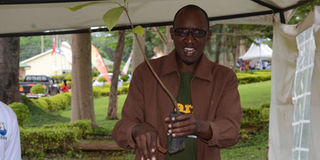Why cocoa farming should be your next investment option

Job Chemutai demonstrates the best practices of cocoa planting. PHOTOs by George Katongole
What you need to know:
Cocoa pods must be opened to remove the beans after harvesting. Farmers are advised to split pods against each other rather than using sharp objects, writes George Katongole
Most people like the taste of the thick dark nectar of sweetness, nutrition, and pleasure of chocolate, yet for the farmers, the smell of money from the food for the gods is assuring.
Job Chemutai Alunga, a crop breeder at the National Coffee Research Institute (NaCORI), in Kituuza, Mukono District says: “Cocoa fetches more money without the farmers necessarily working hard; you harvest every after two weeks for more than 25 years.”
Speaking at the 16th Seeds of Gold Farm Clinic at NaCORI, Chemutai told farmers that cocoa has a big potential that is yet to be exploited. The success of the value chain is hugely dependent on smallholder farmers and Chemutai opines that if more farmers grew cocoa, there would be a massive change in their fortunes.
Why cocoa?
Researchers at NaCORI have embarked on full-scale efforts to sensitise the public on growing of cocoa as a thriving business. Obviously, the numbers are tantalising. Chemutai indicated that NaCORI has developed disease-resistant varieties aimed at enabling farmers get high yields. They are also working on cocoa cuttings which are yet to be put on market. Chemutai said cocoa, which used to be at Shs500 per kilogramme in 1997, now costs up to Shs8,000 per kilogramme . “This is almost three times the price of coffee beans, Uganda’s biggest export commodity,” he said.
Cocoa traces its origins to South America but it was a Swedish botanist, Carl Linnaeus, who classified cocoa and renamed it Theobroma Latin, to mean food for the gods. Although commercial consumption climaxed in 1876 with the creation of chocolate milk, the first cocoa plant in Uganda was planted at Entebbe Botanical Gardens in 1901. Commercial exports started in 1917 but the growing of cocoa was abandoned in 1924 due to a drastic drop in international prices. Pests and diseases also attacked the crop. However, it was reintroduced in 1954 in order to diversify export earnings.
NaCORI estimates that there are currently more than 13,000 farmers growing cocoa in Uganda on about 25,000 hectares of land. In 2016 cocoa earned the country more than $56m (Shs180b) in foreign exchange making it a strategically important crop.
Where does cocoa grow?
Currently, cocoa is mainly grown in Bundibugyo, Hoima and Mukono districts. Chemutai says there are many other areas where cocoa can be grown.
“Cocoa requires deep and well drained soils. Most parts of Uganda have such characteristics. Actually, wherever coffee can thrive, even cocoa can be grown,” he says.
He recommends carrying out soil tests before growing cocoa as the plant thrives in soils with an acidity (pH) range of 6.5 to 7.0.
NaCORI has embarked on mass distribution of cocoa seedlings to farmers through Operation Wealth Creation (OWC).
Chemutai says a cocoa tree takes between three and five years to mature depending on the breed. The most dominant cocoa pods grown in Uganda is criollo, which is purple in colour, as well as forastero, which has a yellow pod.
Management
Proper agronomic practices are vital for getting the best out of a cocoa garden. Farmers must always replace seedlings that have not grown, remove weeds and keep the soil covered, prune the cocoa trees, apply fertiliser and protect the trees from insects and diseases.
To provide a good growth medium for seedlings to be planted, the planting hole should be of sufficient size. Plants are spaced 3x3m or 4x2m, while the commonly used size of the hole is 60X60X60cm.
When pods are ripe, they should be removed from the trees to extract the wet beans. Chemutai advises that the planting hole should be made about six months prior to planting.
Top soil and sub soil are put around the hole in the opposite direction.
He advises adding organic matter with top soil placed at the bottom of the hole, then sub soil at the top.
Chemutai advises on setting up shade for the plants.
“Cocoa is a forest plant and thrives under conditions with minimum exposure to the sun,” he says.
Harvesting
Chemutai says pods are suitable for harvest for three to four weeks, after which time the beans begin to germinate.
“It is, therefore, necessary to harvest at regular intervals as the pods do not all ripen at the same time,” he says.
The pods are harvested manually by making a clean cut through the stalk with a well sharpened blade.
For pods high on the tree, a pruning hook type of tool/stick can be used. By pushing or pulling, the farmer should avoid damaging the branch which bears fruit.
Chemutai advises on taking care in order not to damage the flower cushion which will produce the flowers and fruits of subsequent harvests, as well as avoiding damage to the tree, which would make it easy for parasitic fungi to penetrate the tissues of the tree.
The pods are opened to remove the beans within a week to 10 days after harvesting.
Chemutai prefers splitting pods against each other rather than using sharp objects to minimise damage to the seeds. Some farmers also split the pods using a wooden club. Beans are scooped with hand. “The hands must be very clean during this process. After scooping the beans, you must place them on a clean surface,” says Chemutai.
He advises on doing this at the farm before seeds are taken for fermenting before splitting.
Money matters
According to Chemutai, the average cocoa farm will produce one or two tonnes of cocoa beans a year. One tonne is 16 sacks of cocoa. The average farmer will make between $1,400 and $2,000 (Shs5m-7m) profits a year, at most about $5 (Shs20,000) a day.




